Abstract
There are a number of yeasts that secrete killer toxins, i.e., proteins lethal to sensitive cells of the same or related species. Ustilago maydis, a fungal pathogen of maize, also secretes killer toxins. The best characterized of the U. maydis killer toxins is the KP6 toxin, which consists of two small polypeptides that are not covalently linked. In this work, we show that both are encoded by one segment of the genome of a double-stranded RNA virus. They are synthesized as a preprotoxin that is processed in a manner very similar to that of the Saccharomyces cerevisiae k1 killer toxin, also encoded by a double-strand RNA virus. Active U. maydis KP6 toxin was secreted from S. cerevisiae transformants expressing the KP6 preprotoxin. The two secreted polypeptides were not glycosylated in U. maydis, but one was glycosylated in S. cerevisiae. Comparison of known and predicted cleavage sites among the five killer toxins of known sequence established a three-amino-acid specificity for a KEX2-like enzyme and predicted a new, undescribed processing enzyme in the secretory pathway in the fungi. The mature KP6 toxin polypeptides had hydrophobicity profiles similar to those of other known cellular toxins.
Full text
PDF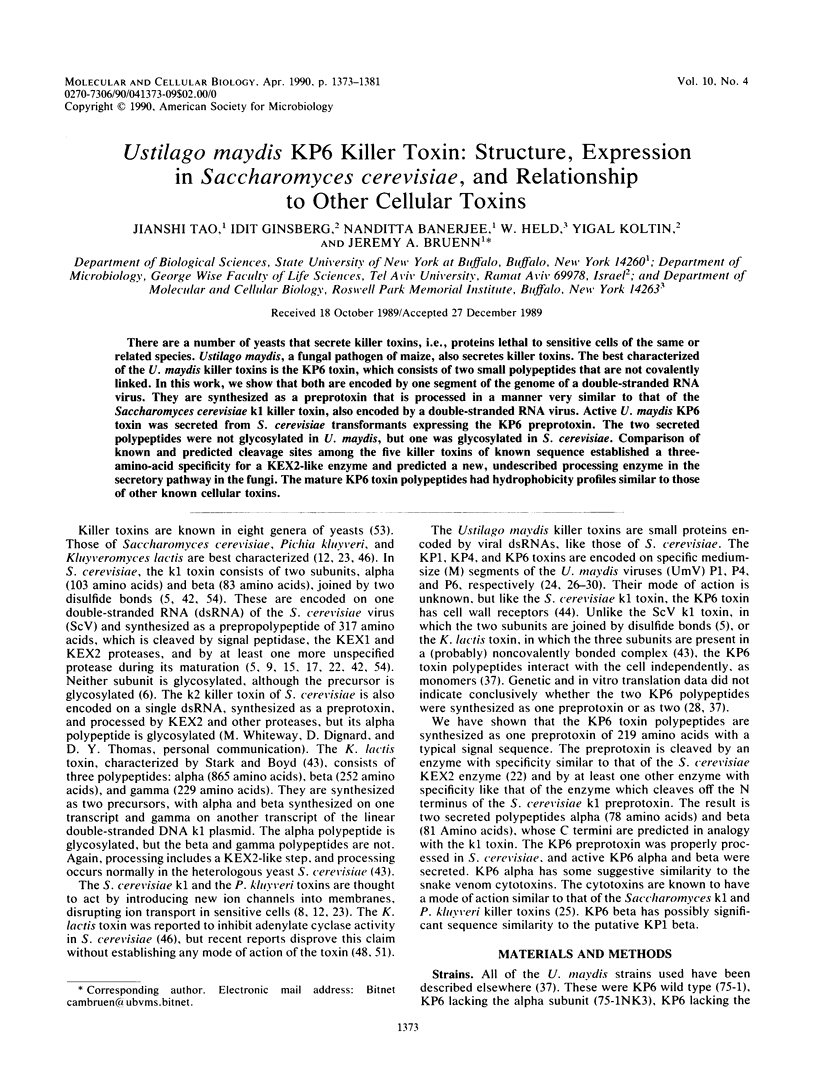
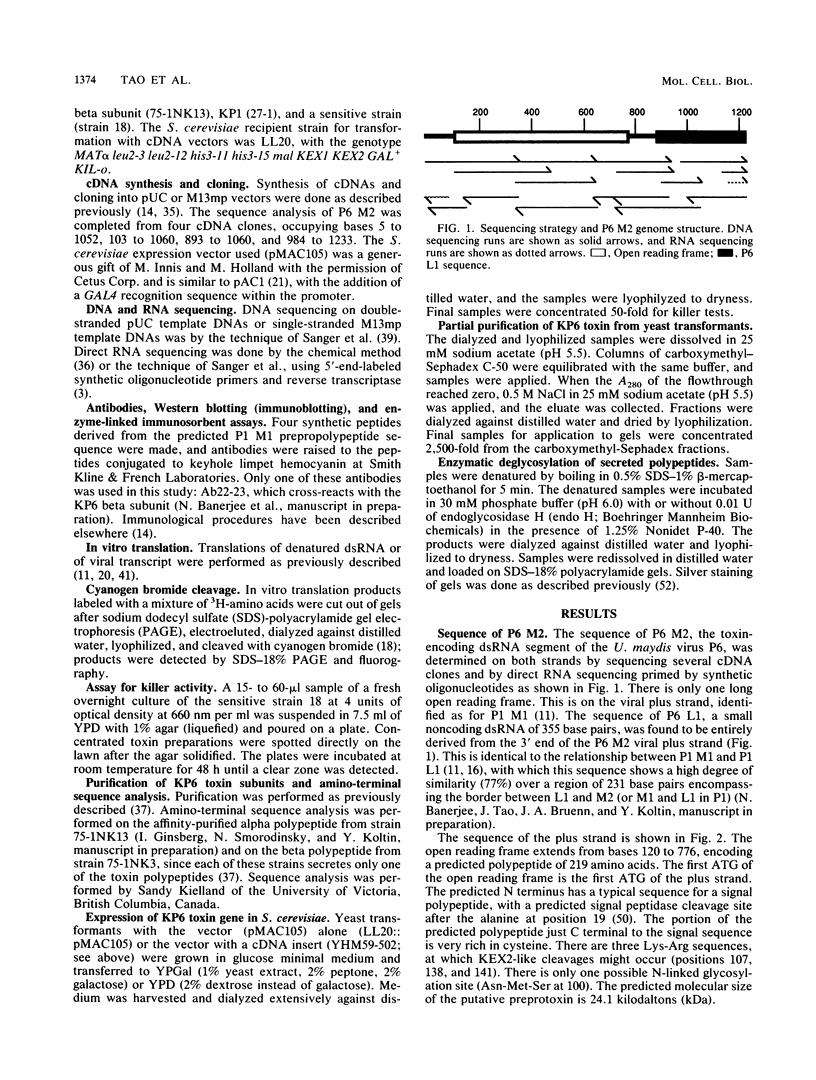
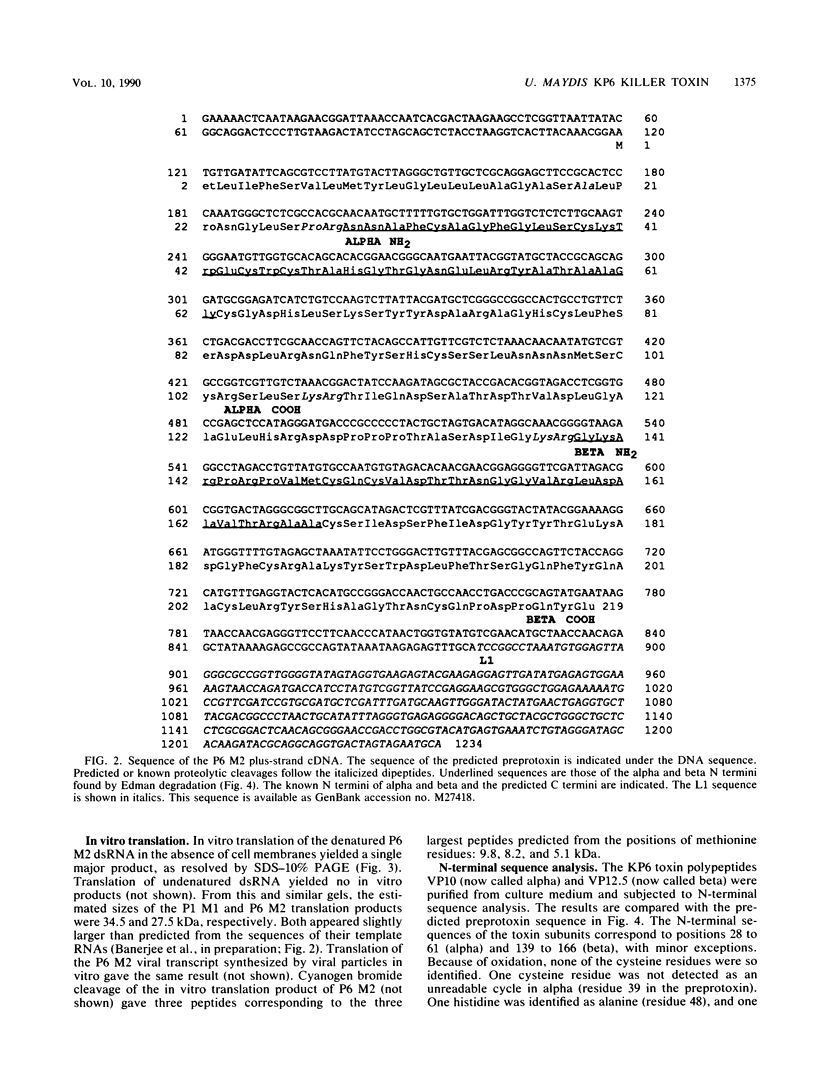

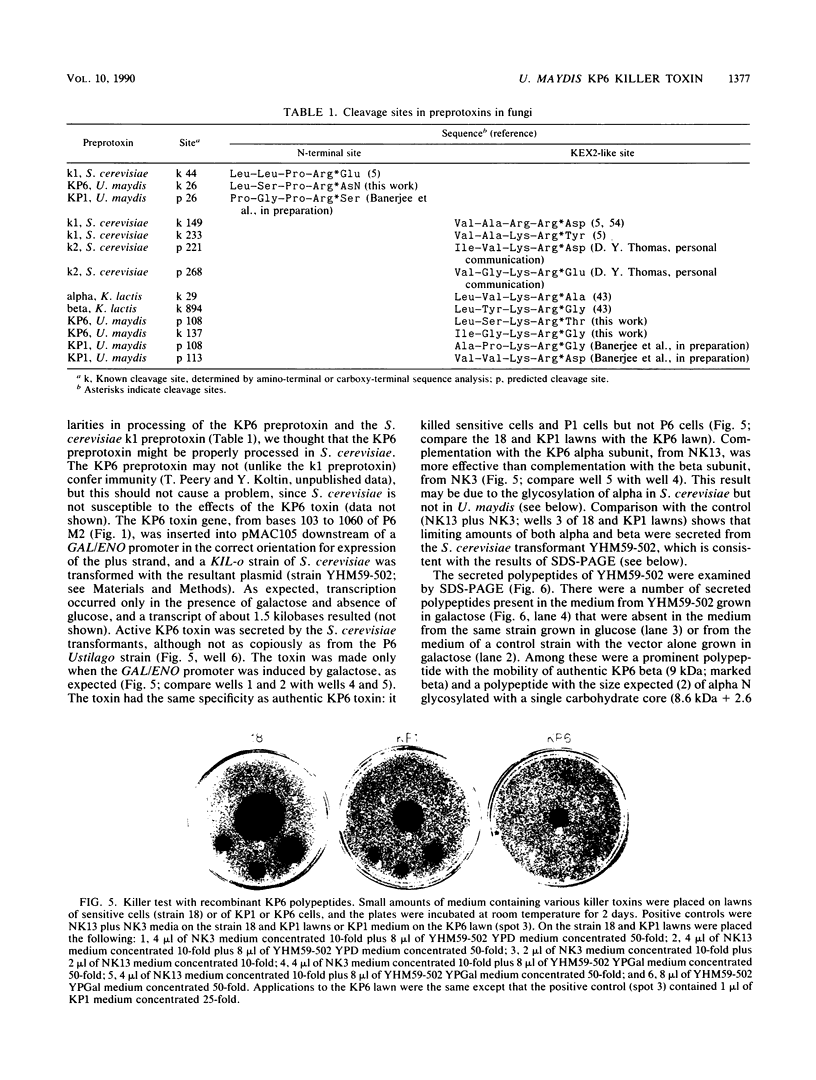
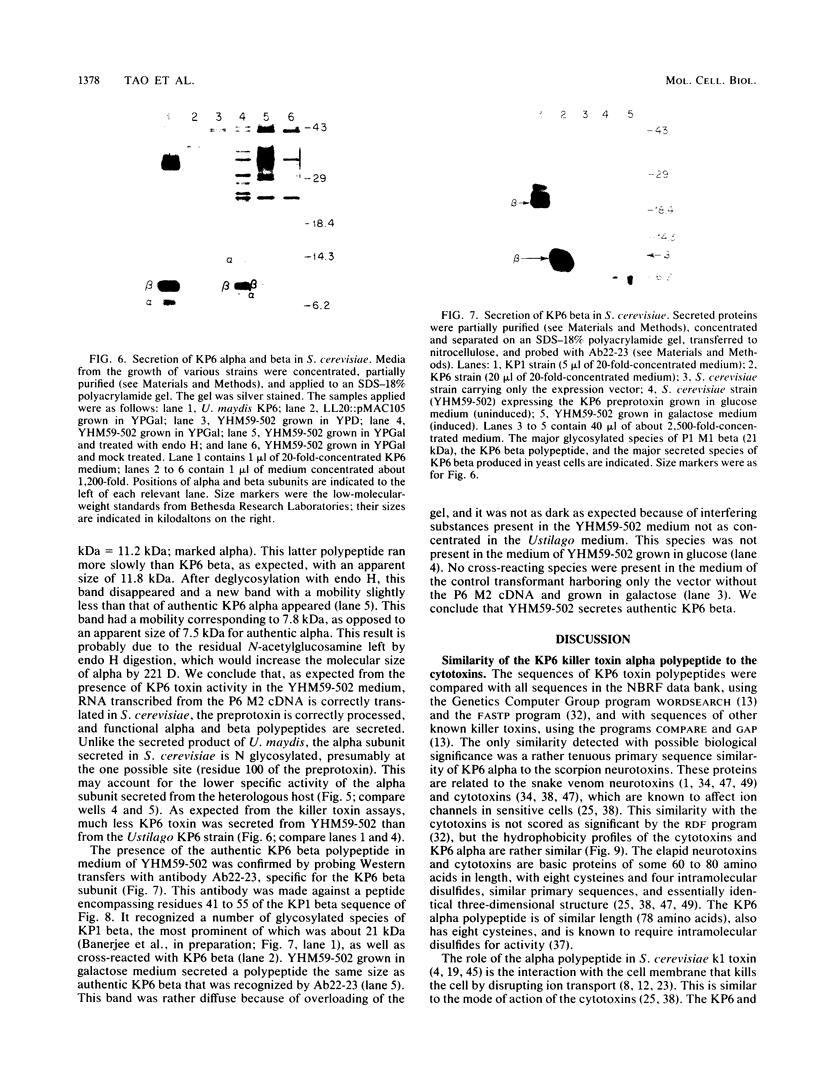

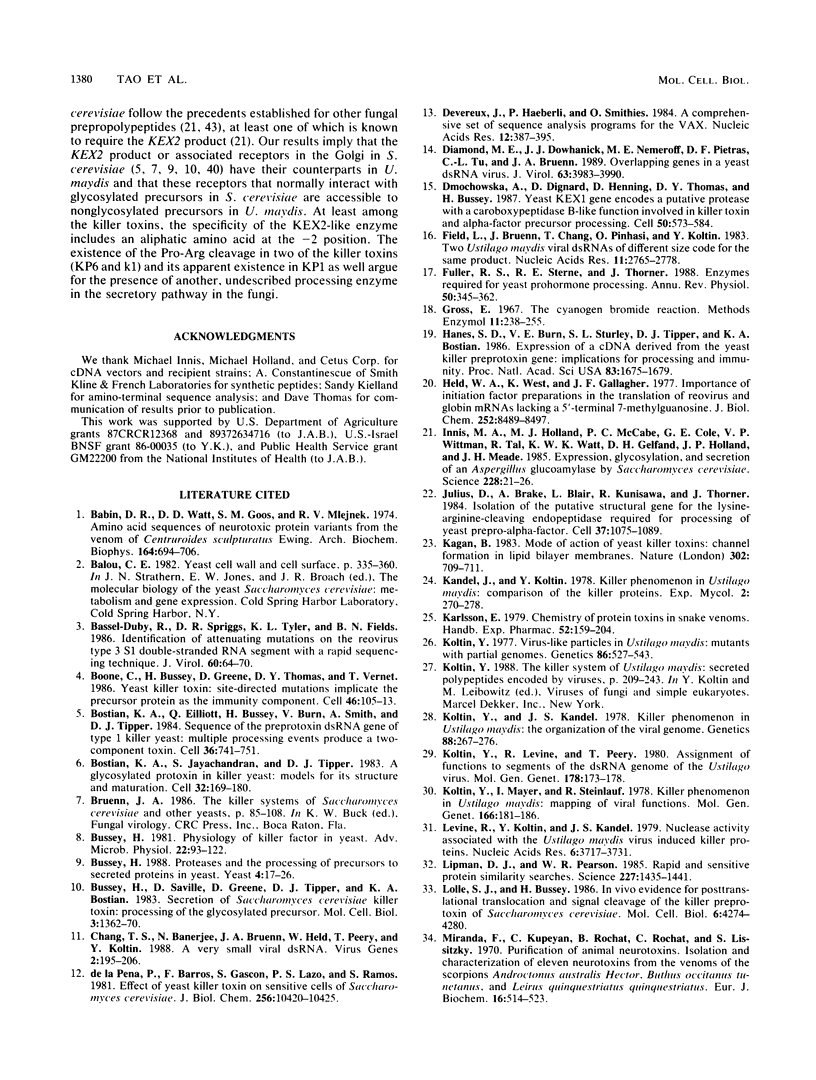
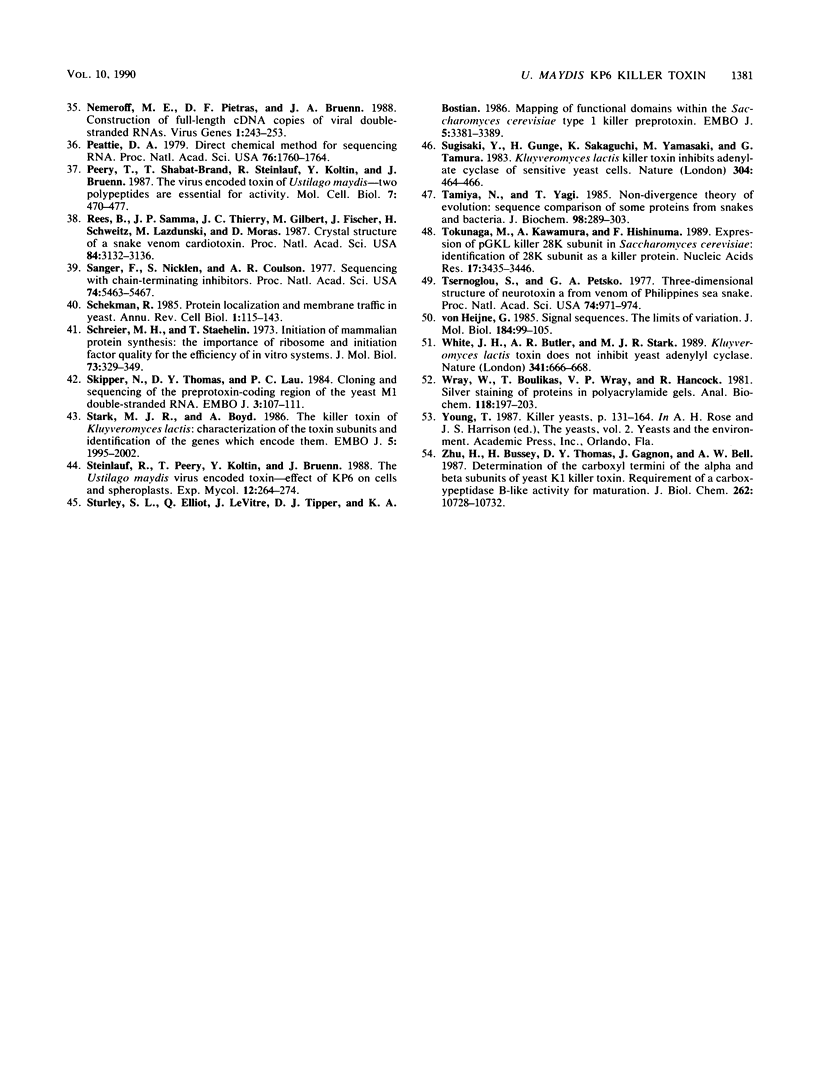
Images in this article
Selected References
These references are in PubMed. This may not be the complete list of references from this article.
- Babin D. R., Watt D. D., Goos S. M., Mlejnek R. V. Amino acid sequences of neurotoxic protein variants from the venom of Centruroides sculpturatus Ewing. Arch Biochem Biophys. 1974 Oct;164(2):694–706. doi: 10.1016/0003-9861(74)90082-4. [DOI] [PubMed] [Google Scholar]
- Bassel-Duby R., Spriggs D. R., Tyler K. L., Fields B. N. Identification of attenuating mutations on the reovirus type 3 S1 double-stranded RNA segment with a rapid sequencing technique. J Virol. 1986 Oct;60(1):64–67. doi: 10.1128/jvi.60.1.64-67.1986. [DOI] [PMC free article] [PubMed] [Google Scholar]
- Boone C., Bussey H., Greene D., Thomas D. Y., Vernet T. Yeast killer toxin: site-directed mutations implicate the precursor protein as the immunity component. Cell. 1986 Jul 4;46(1):105–113. doi: 10.1016/0092-8674(86)90864-0. [DOI] [PubMed] [Google Scholar]
- Bostian K. A., Elliott Q., Bussey H., Burn V., Smith A., Tipper D. J. Sequence of the preprotoxin dsRNA gene of type I killer yeast: multiple processing events produce a two-component toxin. Cell. 1984 Mar;36(3):741–751. doi: 10.1016/0092-8674(84)90354-4. [DOI] [PubMed] [Google Scholar]
- Bostian K. A., Jayachandran S., Tipper D. J. A glycosylated protoxin in killer yeast: models for its structure and maturation. Cell. 1983 Jan;32(1):169–180. doi: 10.1016/0092-8674(83)90507-x. [DOI] [PubMed] [Google Scholar]
- Bussey H. Physiology of killer factor in yeast. Adv Microb Physiol. 1981;22:93–122. doi: 10.1016/s0065-2911(08)60326-4. [DOI] [PubMed] [Google Scholar]
- Bussey H. Proteases and the processing of precursors to secreted proteins in yeast. Yeast. 1988 Mar;4(1):17–26. doi: 10.1002/yea.320040103. [DOI] [PubMed] [Google Scholar]
- Bussey H., Saville D., Greene D., Tipper D. J., Bostian K. A. Secretion of Saccharomyces cerevisiae killer toxin: processing of the glycosylated precursor. Mol Cell Biol. 1983 Aug;3(8):1362–1370. doi: 10.1128/mcb.3.8.1362. [DOI] [PMC free article] [PubMed] [Google Scholar]
- Chang T. H., Banerjee N., Bruenn J., Held W., Peery T., Koltin Y. A very small viral double-stranded RNA. Virus Genes. 1989 Mar;2(2):195–206. doi: 10.1007/BF00315263. [DOI] [PubMed] [Google Scholar]
- Devereux J., Haeberli P., Smithies O. A comprehensive set of sequence analysis programs for the VAX. Nucleic Acids Res. 1984 Jan 11;12(1 Pt 1):387–395. doi: 10.1093/nar/12.1part1.387. [DOI] [PMC free article] [PubMed] [Google Scholar]
- Diamond M. E., Dowhanick J. J., Nemeroff M. E., Pietras D. F., Tu C. L., Bruenn J. A. Overlapping genes in a yeast double-stranded RNA virus. J Virol. 1989 Sep;63(9):3983–3990. doi: 10.1128/jvi.63.9.3983-3990.1989. [DOI] [PMC free article] [PubMed] [Google Scholar]
- Dmochowska A., Dignard D., Henning D., Thomas D. Y., Bussey H. Yeast KEX1 gene encodes a putative protease with a carboxypeptidase B-like function involved in killer toxin and alpha-factor precursor processing. Cell. 1987 Aug 14;50(4):573–584. doi: 10.1016/0092-8674(87)90030-4. [DOI] [PubMed] [Google Scholar]
- Field L. J., Bruenn J. A., Chang T. H., Pinhasi O., Koltin Y. Two Ustilago maydis viral dsRNAs of different size code for the same product. Nucleic Acids Res. 1983 May 11;11(9):2765–2778. doi: 10.1093/nar/11.9.2765. [DOI] [PMC free article] [PubMed] [Google Scholar]
- Fuller R. S., Sterne R. E., Thorner J. Enzymes required for yeast prohormone processing. Annu Rev Physiol. 1988;50:345–362. doi: 10.1146/annurev.ph.50.030188.002021. [DOI] [PubMed] [Google Scholar]
- Hanes S. D., Burn V. E., Sturley S. L., Tipper D. J., Bostian K. A. Expression of a cDNA derived from the yeast killer preprotoxin gene: implications for processing and immunity. Proc Natl Acad Sci U S A. 1986 Mar;83(6):1675–1679. doi: 10.1073/pnas.83.6.1675. [DOI] [PMC free article] [PubMed] [Google Scholar]
- Held W. A., West K., Gallagher J. F. Importance of initiation factor preparations in the translation of reovirus and globin mRNAs lacking a 5'-terminal 7-methylguanosine. J Biol Chem. 1977 Dec 10;252(23):8489–8497. [PubMed] [Google Scholar]
- Innis M. A., Holland M. J., McCabe P. C., Cole G. E., Wittman V. P., Tal R., Watt K. W., Gelfand D. H., Holland J. P., Meade J. H. Expression, Glycosylation, and Secretion of an Aspergillus Glucoamylase by Saccharomyces cerevisiae. Science. 1985 Apr 5;228(4695):21–26. doi: 10.1126/science.228.4695.21. [DOI] [PubMed] [Google Scholar]
- Julius D., Brake A., Blair L., Kunisawa R., Thorner J. Isolation of the putative structural gene for the lysine-arginine-cleaving endopeptidase required for processing of yeast prepro-alpha-factor. Cell. 1984 Jul;37(3):1075–1089. doi: 10.1016/0092-8674(84)90442-2. [DOI] [PubMed] [Google Scholar]
- Kagan B. L. Mode of action of yeast killer toxins: channel formation in lipid bilayer membranes. Nature. 1983 Apr 21;302(5910):709–711. doi: 10.1038/302709a0. [DOI] [PubMed] [Google Scholar]
- Koltin Y., Kandel J. S. Killer Phenomenon in USTILAGO MAYDIS: The Organization of the Viral Genome. Genetics. 1978 Feb;88(2):267–276. doi: 10.1093/genetics/88.2.267. [DOI] [PMC free article] [PubMed] [Google Scholar]
- Koltin Y., Levine R., Peery T. Assignment of functions to segments of the DsRNA genome of the Ustilago virus. Mol Gen Genet. 1980 Apr;178(1):173–178. doi: 10.1007/BF00267226. [DOI] [PubMed] [Google Scholar]
- Koltin Y., Mayer I., Steinlauf R. Killer phenomenon in Ustilago maydis: mapping viral functions. Mol Gen Genet. 1978 Oct 30;166(2):181–186. doi: 10.1007/BF00285920. [DOI] [PubMed] [Google Scholar]
- Koltin Y. Virus-like particles in Ustilago maydis: mutants with partial genomes. Genetics. 1977 Jul;86(3):527–534. doi: 10.1093/genetics/86.3.527. [DOI] [PMC free article] [PubMed] [Google Scholar]
- Levine R., Koltin Y., Kandel J. Nuclease activity associated with the Ustilago maydis virus induced killer proteins. Nucleic Acids Res. 1979 Aug 24;6(12):3717–3731. doi: 10.1093/nar/6.12.3717. [DOI] [PMC free article] [PubMed] [Google Scholar]
- Lipman D. J., Pearson W. R. Rapid and sensitive protein similarity searches. Science. 1985 Mar 22;227(4693):1435–1441. doi: 10.1126/science.2983426. [DOI] [PubMed] [Google Scholar]
- Lolle S. J., Bussey H. In vivo evidence for posttranslational translocation and signal cleavage of the killer preprotoxin of Saccharomyces cerevisiae. Mol Cell Biol. 1986 Dec;6(12):4274–4280. doi: 10.1128/mcb.6.12.4274. [DOI] [PMC free article] [PubMed] [Google Scholar]
- Miranda F., Kupeyan C., Rochat H., Rochat C., Lissitzky S. Purification of animal neurotoxins. Isolation and characterization of eleven neurotoxins from the venoms of the scorpions Androctonus australis hector, Buthus occitanus tunetanus and Leiurus quinquestriatus quinquestriatus. Eur J Biochem. 1970 Nov;16(3):514–523. doi: 10.1111/j.1432-1033.1970.tb01111.x. [DOI] [PubMed] [Google Scholar]
- Nemeroff M. E., Pietras D. F., Bruenn J. A. Construction of full-length cDNA copies of viral double-stranded RNA. Virus Genes. 1988 Jun;1(3):243–253. doi: 10.1007/BF00572703. [DOI] [PubMed] [Google Scholar]
- Peattie D. A. Direct chemical method for sequencing RNA. Proc Natl Acad Sci U S A. 1979 Apr;76(4):1760–1764. doi: 10.1073/pnas.76.4.1760. [DOI] [PMC free article] [PubMed] [Google Scholar]
- Peery T., Shabat-Brand T., Steinlauf R., Koltin Y., Bruenn J. Virus-encoded toxin of Ustilago maydis: two polypeptides are essential for activity. Mol Cell Biol. 1987 Jan;7(1):470–477. doi: 10.1128/mcb.7.1.470. [DOI] [PMC free article] [PubMed] [Google Scholar]
- Rees B., Samama J. P., Thierry J. C., Gilibert M., Fischer J., Schweitz H., Lazdunski M., Moras D. Crystal structure of a snake venom cardiotoxin. Proc Natl Acad Sci U S A. 1987 May;84(10):3132–3136. doi: 10.1073/pnas.84.10.3132. [DOI] [PMC free article] [PubMed] [Google Scholar]
- Sanger F., Nicklen S., Coulson A. R. DNA sequencing with chain-terminating inhibitors. Proc Natl Acad Sci U S A. 1977 Dec;74(12):5463–5467. doi: 10.1073/pnas.74.12.5463. [DOI] [PMC free article] [PubMed] [Google Scholar]
- Schekman R. Protein localization and membrane traffic in yeast. Annu Rev Cell Biol. 1985;1:115–143. doi: 10.1146/annurev.cb.01.110185.000555. [DOI] [PubMed] [Google Scholar]
- Schreier M. H., Staehelin T. Initiation of mammalian protein synthesis: the importance of ribosome and initiation factor quality for the efficiency of in vitro systems. J Mol Biol. 1973 Feb 19;73(3):329–349. doi: 10.1016/0022-2836(73)90346-x. [DOI] [PubMed] [Google Scholar]
- Skipper N., Thomas D. Y., Lau P. C. Cloning and sequencing of the preprotoxin-coding region of the yeast M1 double-stranded RNA. EMBO J. 1984 Jan;3(1):107–111. doi: 10.1002/j.1460-2075.1984.tb01769.x. [DOI] [PMC free article] [PubMed] [Google Scholar]
- Stark M. J., Boyd A. The killer toxin of Kluyveromyces lactis: characterization of the toxin subunits and identification of the genes which encode them. EMBO J. 1986 Aug;5(8):1995–2002. doi: 10.1002/j.1460-2075.1986.tb04455.x. [DOI] [PMC free article] [PubMed] [Google Scholar]
- Sturley S. L., Elliot Q., LeVitre J., Tipper D. J., Bostian K. A. Mapping of functional domains within the Saccharomyces cerevisiae type 1 killer preprotoxin. EMBO J. 1986 Dec 1;5(12):3381–3389. doi: 10.1002/j.1460-2075.1986.tb04654.x. [DOI] [PMC free article] [PubMed] [Google Scholar]
- Sugisaki Y., Gunge N., Sakaguchi K., Yamasaki M., Tamura G. Kluyveromyces lactis killer toxin inhibits adenylate cyclase of sensitive yeast cells. Nature. 1983 Aug 4;304(5925):464–466. doi: 10.1038/304464a0. [DOI] [PubMed] [Google Scholar]
- Tamiya N., Yagi T. Non-divergence theory of evolution: sequence comparison of some proteins from snakes and bacteria. J Biochem. 1985 Aug;98(2):289–303. doi: 10.1093/oxfordjournals.jbchem.a135282. [DOI] [PubMed] [Google Scholar]
- Tokunaga M., Kawamura A., Hishinuma F. Expression of pGKL killer 28K subunit in Saccharomyces cerevisiae: identification of 28K subunit as a killer protein. Nucleic Acids Res. 1989 May 11;17(9):3435–3446. doi: 10.1093/nar/17.9.3435. [DOI] [PMC free article] [PubMed] [Google Scholar]
- Tsernoglou D., Petsko G. A. Three-dimensional structure of neurotoxin a from venom of the Philippines sea snake. Proc Natl Acad Sci U S A. 1977 Mar;74(3):971–974. doi: 10.1073/pnas.74.3.971. [DOI] [PMC free article] [PubMed] [Google Scholar]
- Wray W., Boulikas T., Wray V. P., Hancock R. Silver staining of proteins in polyacrylamide gels. Anal Biochem. 1981 Nov 15;118(1):197–203. doi: 10.1016/0003-2697(81)90179-2. [DOI] [PubMed] [Google Scholar]
- Zhu H., Bussey H., Thomas D. Y., Gagnon J., Bell A. W. Determination of the carboxyl termini of the alpha and beta subunits of yeast K1 killer toxin. Requirement of a carboxypeptidase B-like activity for maturation. J Biol Chem. 1987 Aug 5;262(22):10728–10732. [PubMed] [Google Scholar]
- de la Peña P., Barros F., Gascón S., Lazo P. S., Ramos S. Effect of yeast killer toxin on sensitive cells of Saccharomyces cerevisiae. J Biol Chem. 1981 Oct 25;256(20):10420–10425. [PubMed] [Google Scholar]
- von Heijne G. Signal sequences. The limits of variation. J Mol Biol. 1985 Jul 5;184(1):99–105. doi: 10.1016/0022-2836(85)90046-4. [DOI] [PubMed] [Google Scholar]






